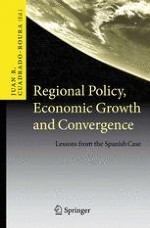2010 | OriginalPaper | Buchkapitel
6. The Sources of Spanish Regional Growth
verfasst von : Matilde Mas, Francisco Pérez, Javier Quesada
Erschienen in: Regional Policy, Economic Growth and Convergence
Verlag: Springer Berlin Heidelberg
Aktivieren Sie unsere intelligente Suche, um passende Fachinhalte oder Patente zu finden.
Wählen Sie Textabschnitte aus um mit Künstlicher Intelligenz passenden Patente zu finden. powered by
Markieren Sie Textabschnitte, um KI-gestützt weitere passende Inhalte zu finden. powered by
